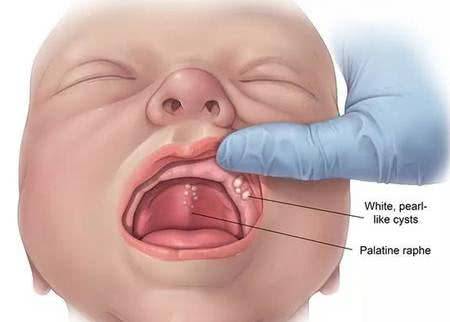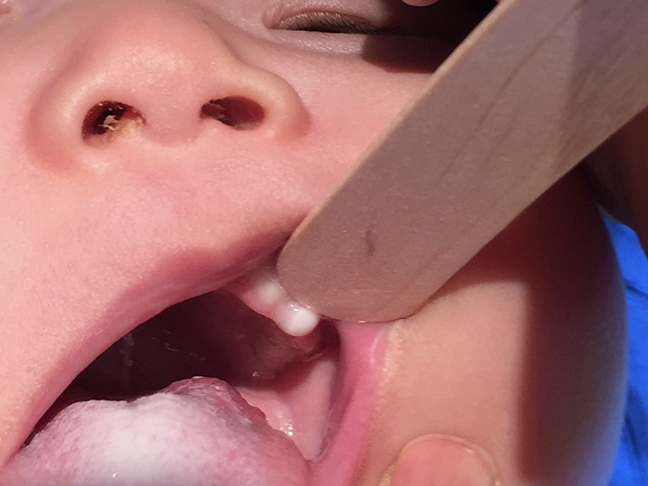Horse teeth
SYMPTOMS
What is "horse teeth"?
"Horse teeth" is a colloquial term for "oral inclusion cysts," also known as "board teeth" or medically referred to as "epithelial pearls."
Oral inclusion cysts are 1–4 mm nodules containing keratin, similar to milia. They primarily appear on the midline of the palate and/or gums of newborns and infants, presenting as yellowish-white granular papules (Figures 1 and 2), slightly raised above the palate or gum surface.
What causes "horse teeth"?
Medically, it is believed to result from fusion abnormalities, residual minor salivary gland secretions, epithelial cell accumulation, or remnants of the fetal dental lamina. These manifest as single or multiple white or translucent round papules that cannot be wiped away.
What are the different types of "horse teeth"?
In 1967, Fromm classified oral inclusion cysts histologically and by location. They are also referred to by different names based on their location: "Epstein pearls," "Bohn nodules," and "dental lamina cysts."
-
Those located on the median palatine raphe are called Epstein pearls (Figure 1), likely originating from residual epithelial cells during embryonic palatal fusion.
-
Those found on the palate or gingival ridges are termed Bohn nodules (Figure 2), possibly arising from remnants of palatal salivary gland structures.
-
Dental lamina cysts appear as white or pinkish small nodules, often multiple, mostly on the mid-palate, and occasionally on the maxillary or mandibular alveolar ridges. Those on the alveolar ridges may originate from remnants of the fetal dental lamina and should be differentiated from natal teeth and neonatal teeth.


TREATMENT
Do Epithelial Pearls Need Treatment?
Epithelial pearls usually do not affect an infant's ability to feed or the eruption of primary teeth. They typically disappear on their own within weeks to months after birth and require no special treatment.
Avoid puncturing them to prevent infection.
In rare cases where epithelial pearls cause localized symptoms such as sucking pain or bleeding, surgical removal may be performed by a dentist after evaluation.
DIAGNOSIS
Which department should I visit for Epstein pearls?
The diagnosis can be made based on typical "Epstein pearls" manifestations, and medical consultation is usually unnecessary. If parents are unable to judge on their own, they may visit the pediatrics, child healthcare, or dentistry department.
What diseases should Epstein pearls be differentiated from?
Oral inclusion cysts should be distinguished from eruption cysts, hematomas (Figure 3), natal or neonatal teeth (Figure 4), and oral thrush (Figure 5).
- Eruption cysts and hematomas
An eruption cyst is a semicircular soft tissue lesion associated with the eruption of primary or permanent teeth, caused by the accumulation of tissue fluid in the follicular space of the erupting tooth. When the cystic fluid contains blood, it is called an eruption hematoma. No treatment is required, as the cyst will resolve on its own after the tooth erupts. If the tooth does not emerge within 2 weeks, further evaluation is needed to assess other possible causes.

- Natal or neonatal teeth
Natal teeth are present in the oral cavity at birth, while neonatal teeth erupt during the newborn period. Most natal teeth are mandibular central incisors and are normal teeth, not supernumerary. They may occur in otherwise healthy children, with or without a family history.
Prematurely erupted primary teeth generally have a normal crown morphology, but the enamel and dentin are thin and poorly mineralized, with underdeveloped or minimal root formation. These teeth are loosely attached to the mucoperiosteum without alveolar bone support, making them mobile or extremely loose. Excessive mobility may interfere with breastfeeding or pose a risk of aspiration.
Premature eruption of primary teeth may also be associated with various syndromes, including chondroectodermal dysplasia, pachyonychia congenita, Sotos syndrome, and Hallermann-Streiff syndrome.
Management may include observation, rounding the incisal edge (to prevent discomfort and oral ulcers during breastfeeding), or extraction. Extraction should only be considered if natal or neonatal teeth cause feeding difficulties. Overly mobile teeth, posing an aspiration risk, are also recommended for removal.

- Oral thrush
Oral thrush presents as white plaques on the buccal mucosa, palate, tongue, or oropharyngeal surface (Figure 5). Infants with thrush may be asymptomatic or may refuse to feed due to discomfort caused by the infection.

POTENTIAL DISEASES
Are horse teeth related to other diseases?
Horse teeth are a special physiological manifestation and do not indicate other abnormal diseases.